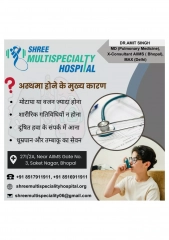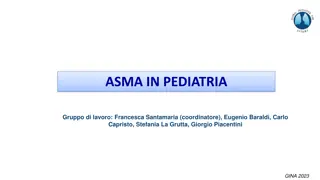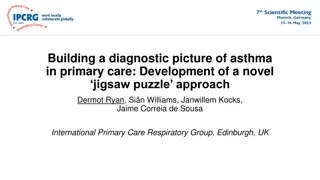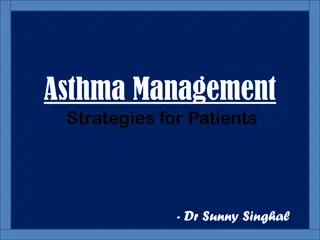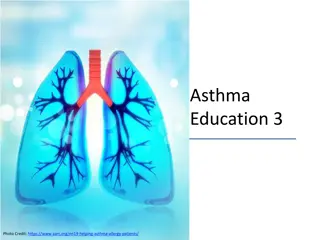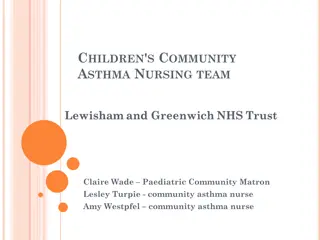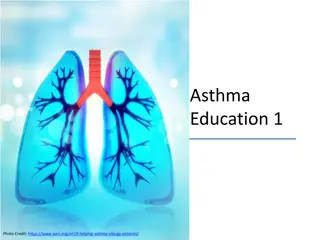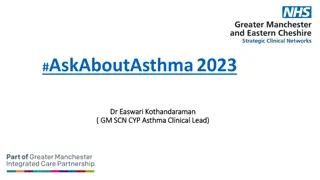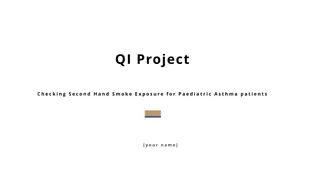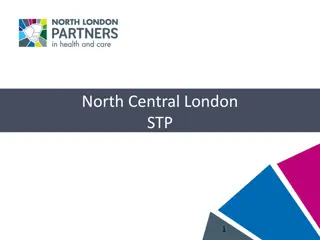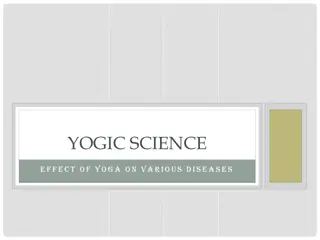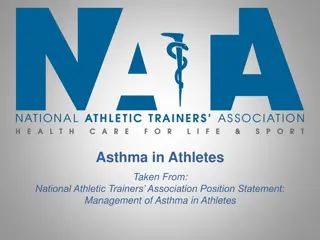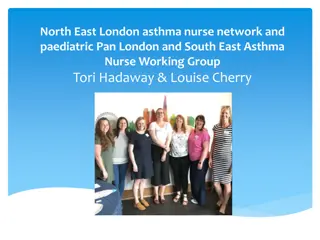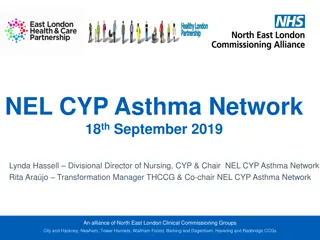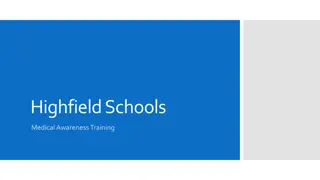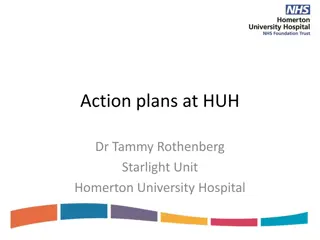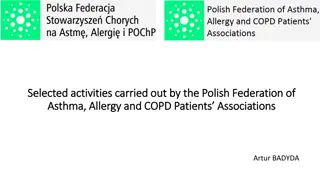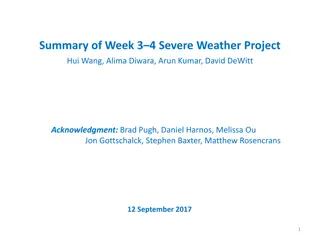Comprehensive Review of Severe Asthma Management in Clinical Practice
In this case study, we explore the journey of Mr. Y, a 60-year-old man with a history of breathing problems. Despite initial treatment, his condition worsened, leading to multiple exacerbations. With a focus on the 2019 BTS/SIGN guidelines, his management included treatment escalation with LAMA and Uniphyllin. However, challenges persisted, prompting referral to a severe asthma MDT for further evaluation and personalized care.
Download Presentation

Please find below an Image/Link to download the presentation.
The content on the website is provided AS IS for your information and personal use only. It may not be sold, licensed, or shared on other websites without obtaining consent from the author.If you encounter any issues during the download, it is possible that the publisher has removed the file from their server.
You are allowed to download the files provided on this website for personal or commercial use, subject to the condition that they are used lawfully. All files are the property of their respective owners.
The content on the website is provided AS IS for your information and personal use only. It may not be sold, licensed, or shared on other websites without obtaining consent from the author.
E N D
Presentation Transcript
An Asthma Success Story Hannah Carlin 14/7/21
Review a case from the NUTH Severe Asthma MDT Clinic Objectives Review relevant points from the 2019 BTS/Sign guidelines for diagnosis and management of asthma
60 year old man Onset of breathing problems aged 50 Background: Hay fever No history of childhood respiratory illness or prematurity No rhinosinusitis or atopy Lifelong nonsmoker No pets Factory worker until age 54; no occupational asbestos, dust or fume exposure Mr Y
Presented to secondary care in 2018 History: Chest tightness, wheeze and productive cough which is episodic in nature. 4 exacerbations requiring oral steroids in 12 months prior to referral Taking DuoResp320/9 2 puffs BD + PRN salbutamol Mr Y GP has tried montelukast -ineffective Examination: BMI 29. Chest clear Next steps?
Eosinophils 0.9 IgE71 Investigations RAST positive to grass CT thorax: Normal
BTS/SIGN suggested treatment escalation
Addition of LAMA (glycopyrronium55mcg mane) Management Addition of Uniphyllin400mcg BD
Continues to exacerbate- 6 exacerbations /year Not limited by breathlessness or cough in between exacerbations Management Commenced on omeprazole for reflux symptoms Referred to severe asthma MDT
BTS: Difficult asthma : patients with poor control despite high dose ICS or medium dose ICS + montelukast Severe Asthma GINA: Difficult to treat asthma: uncontrolled despite step 4/5 treatment Severe asthma: uncontrolled despite adherence with optimal step 4/5 treatment and treatment of contributory factors
NHS England Specification for Severe Asthma Services Patients with severe asthma need to be considered as a separate group from the majority of people with mild to moderate disease. Severe Asthma Those with severe asthma require systematic assessment and specialist care in tertiary respiratory centres To improve outcomes for people with severe asthma to act as clinical gatekeepers to ensure appropriate access to high cost technologies (including biological agents and referral for bronchial thermoplasty)
A planned multi-disciplinary assessment should be undertaken. Pre-planned investigations, to include measures of airway inflammation and airways hyperreactivity Assessment to include allergy, ENT and physiotherapy review in all cases. Severe Asthma Review of adherence in all cases including measurement of blood levels of prednisolone and cortisol, as well as review of prescription refills and pick up from primary care and FeNO suppression testing if appropriate. Following initial assessment the decision will be made regarding the patient s suitability for bronchial thermoplastyor high cost novel biological therapies
History reviewed Normally not limited by breathing, MRCD 2, walks several miles per day 6 exacerbations per year Characterised by productive cough (pale green sputum) and breathlessness (reduced to 200m ex tol.) Diurnal variability, occasional nocturnal wakening with breathlessness/cough-less since starting PPI Breathlessness can be associated with panic Mr Y March 2020 Responds rapidly to steroids; last course 3 days previously No admissions BMI 26 Eosinophils 0.66
FeNO: 139ppb March 2020
Physiotherapy Assessment Nijmegen Score 7/64 Small degree of breathing dysfunction shown abdominal breathing exercises and ACBT for productive cough during excacerbations
History features: no vocal changes Waking in night with panic no true PND/orthopnea Improvement in reflux symptoms with omeprazole Videolaryngoscopy: Candidiasis postnasal drip breath holding at rest paradoxical vocal cord movement with arytenoid collapse/ lateral constriction following vocal tasks and in response to aerosol - suggestive of ILO SLT Assessment Sniff/exhale rescue technique taught with biofeedback Cough suppression
GP records- good pick up rate of prescriptions (11/12 ICS) Confirmed 6 x exacerbations per year Specialist Nurse Assessment Suboptimal inhaler technique with DuoResp Spiromax Not exhaling fully before inhalation, not breath holding post inhalation Best PEFR confirmed (500). Action Plan reviewed: steroids when drops to around 50%. PEFR correlates with symptoms. HADS A 2 D 4 (/21)
1. Is asthma the correct diagnosis? Questions for MDT 2. Is asthma the main driver of symptoms? 3. What treatable traits are present? 4. Is the patient on optimal medical treatment, and concordant? (and SpRs!) 5. Does the patient need a biologic drug?
1. Is asthma the correct diagnosis? YES Obstructive spirometry Clinical history of variability (PEFR) though not objectively recorded Biochemical evidence of Type 2 inflammation (peripheral eosinophilia 0.6-0.9, FeNO, raised IgE) Normal investigations exclude bronchiectasis and emphysema Questions for MDT (and SpRs!)
1. Is asthma the correct diagnosis? Questions for MDT 2. Is asthma the main driver of symptoms? PROBABLY High FeNO suggests airways inflammation not suppressed (although: tall male, rhinitis, nonsmoker) Clinical history of oral steroid responsiveness However evidence of ILO and (to a lesser degree) BPD which may exacerbate symptoms (and SpRs!)
1. Is asthma the correct diagnosis? 2. Is asthma the main driver of symptoms? 3. What treatable traits are present? Eosinophilic airways inflammation high dose ICS, could improve technique Smooth muscle contraction- on LAMA, theophylline No evidence emphysema No evidence bacterial inflammation/infection Reflux - already addressed with initial response to treatment Postnasal drip not symptomatic Obesity lost weight since first presentation No evidence deconditioning, physically active ILO will address BPD not major factor but some strategies to address Questions for MDT (and SpRs!)
1. Is asthma the correct diagnosis? Questions for MDT 2. Is asthma the main driver of symptoms? 3. What treatable traits are present? 4. Is the patient on optimal medical treatment, and concordant? YES but suboptimal inhaler technique, and high FeNO /oral thrush also indicate steroid may not be reaching airways (and SpRs!)
1. Is asthma the correct diagnosis? 2. Is asthma the main driver of symptoms? Questions for MDT 3. What treatable traits are present? 4. Is the patient on optimal medical treatment, and concordant? 5. Does the patient need a biologic drug? If so which? Anti-IL-5 (mepolizumab, reslizumab, benralizumab) YES NICE: >4 exac/year + eosinophils >0.3 Mepo/Benra (or 3 per year + 0.4 for Reslizumab/Benra) Omalizumab requires evidence of IgE-mediated allergic asthma with sensitization to perennial allergen - NO (and SpRs!)
Treat oral thrush Coaching in inhaler technique Change to MART regimen Reduce Uniphyllin to OD due to overtherapetic drug level Plan SLT follow up for treatment of ILO Continue omeprazole- night time wakenings possibly laryngospasm triggered by reflux If no improvement with these measures: Refer for mepolizumab
Much improved No further exacerbations Follow up Reduced use of reliever puffs less than once weekly De-escalation in therapy stopped Uniphyllin
Thorough, holistic approach including revisiting supporting evidence for diagnosis and screening for contributing non-asthma pathology Importance of getting the basics correct: Inhaler technique/drug delivery Assessments of concordance Self management NB: All Biologic trials show reductions in oral corticosteroids in the placebo groups! Learning points
BTS/SIGN guidelines on DIAGNOSIS
Clinical assessment EPISODIC symptoms (wheeze, breathlessness, cough, chest tightness) (ideally corroborated by low peak flows) Triggered by viruses / aspirin and NSAIDs / allergen Wheeze heard by a healthcare professional Diurnal variability Atopic history Absence of symptoms and signs to suggest alternative diagnosis Historical record of variable PEFR or FEV1 BTS/SIGN guidelines on DIAGNOSIS Diagnostic tests add supporting evidence but aren t sufficient in isolation
Obstructive spirometry PPV 45-100% / NPV 18 73% Bronchodilator reversibility 12% or more AND 200ml or more PPV 53-82% / NPV 22 68% Peak flow charting (mean variability >20%) PPV 97% / NPV 10% Not clear whether patients in these studies were symptomatic at the time of the charting. One study concluded that the number of days with diurnal variation was more accurate than calculating the mean variation. BTS/SIGN guidelines on DIAGNOSIS FeNO >40ppb PPV 54-95% / NPV 65- 93% 1 in 5 false positives / 1 in 5 false negatives Methacholine challenge PPV 60-100% / NPV 46-100% Most useful to rule out asthma (66% population completely negative test) Peripheral eosinophilia poorly predictive. IgE >100 substantially reduces the probability of asthma in adults with a false negative rate of <1 in 10. Positive result is poorly predictive.
Smoking cessation Weight loss Not enough evidence to recommend allergen avoidance BTS/SIGN guidelines on TREATMENT Self management: substantial body of evidence that written personalized asthma action plans improve outcomes Recognising worsening control via symptoms/PEFR/both 2-3 actions to take including: quadrupling ICS, starting oral steroids, seeking emergency help
BTS/SIGN guidelines on TREATMENT Pharmacological management: Specialist Therapies Tiotropium: LAMA + ICS/LABA better than ICS/LABA alone but ICS dosage different in each RCT High dose ICS (>1000 BDP) Theophylline (data extrapolated from trials of add-on therapy to ICS alone)
Low dose Medium dose High dose Beclomethasone Clenil 100 2 puffs BD 200 2 puffs BD 200 4 puffs BD Extrafine beclomethasone Qvar 50 2 puffs BD 100 2 puffs BD 100 4 puffs BD Fostair MDI/DPI 100/6 1 puff BD 100/6 2 puffs BD 200/6 2 puffs BD BTS/SIGN guidelines on TREATMENT Fluticasone Flixotide MDI 50 2 puffs BD 125 2 puffs BD 250 2 puffs BD Seretide MDI 50/25 2 puffs BD 125/25 2 puffs BD 250/25 2 puffs BD Seretide DPI 100/50 1 puff BD 250/50 1 puff BD 500/50 1 puff BD Relvar DPI - 92/22 1 puff OD 184/22 1 puff OD Budesonide Pulmicort 100 2 puffs BD 200 2 puffs BD 400 2 puffs BD Symbicort 100/6 2 puffs BD 200/6 2 puffs BD 400/12 2 puffs BD DuoResp 160/4.5 1 puff BD 160/4.5 2 puffs BD 320/9 2 puffs BD
MART regime: Maintenance and Reliever Therapy Rapid onset of formeterol (Symbicort, DuoResp, Fostair) As control deteriorates, delivered ICS dose goes up BTS/SIGN guidelines on TREATMENT Cochrane review 2013: MART reduces exacerbations compared to regular ICS alone JAMA meta-analysis 2018: MART reduces exacerbations compared to same dose and higher dose regular ICS/LABA


